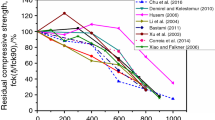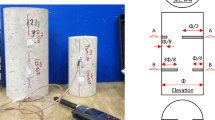Abstract
Concrete structures are liable to be exposed to fire during their lifetime. After exposure to high temperature, the strength of concrete is determined only by its residual properties. The method of cooling, after exposure, is one of the significant factors in determining the residual properties of concrete. The compressive strength, tensile strength, stress-strain response and elastic modulus of concrete are the important properties to be considered in the design of fire resistant structures. In this paper, the behaviour of high temperature exposure of three different grades of concrete M20, M45 and M60 are considered. The specimens were subjected to high temperature regime of 100°C–900°C and were cooled by different methods. The maximum degradation of mechanical properties was observed between temperature regimes of 400°C to 600°C. High strength concrete was found to be more vulnerable compared to normal strength concrete. Mathematical models expressing the variation of different mechanical properties of concrete were developed and explained.














Similar content being viewed by others
References
Yang H, Zhao H, and Liu F 2018 Residual cube strength of coarse RCA concrete after exposure to elevated temperatures. Fire and Materials Journal. 42 (4):424–435
Ulm F J, Coussy O, Bazant Z P 1999 The Chunnel fire. I: Chemoplastic softening in rapidly heated concrete. Journal of Engineering Mechanics. 125 (3): 272–281
Noumowe A and Debicki G 2002 Effect of elevated temperature from 200 to 600 °C on the permeability of high performance concrete. In: Proceedings of the 6th International Symposium on Utilization of high strength/performance concrete (Vol. 1)
Bamonte P and Monte F L 2015 Reinforced concrete columns exposed to standard fire: Comparison among different constitutive models for concrete at high temperature. Fire Safety Journal. 71:310–323
Kodur V 2014 Properties of concrete at elevated temperatures. International Scholarly Research Notices. Article ID 168310: 1–15
Bikhiet M M, El-Shafey N F, and El-Hashimy H M 2014 Behavior of reinforced concrete short columns exposed to fire. Alexandria Eng. J. 53:643–653
Mehta P K and Monteiro P J 2017 Chapter 3: Strength. Concrete microstructure, properties and materials. McGraw-Hill New York USA, 3rd Edition. pp. 49–84
Mindess S, Young J F and Darwin D 2003 Concrete. 2nd Edition, Prentice – Hall, Upper Saddle River
Khaliq W and Kodur V 2012. High Temperature Mechanical Properties of High-Strength Fly Ash Concrete with and without Fibers. ACI Materials Journal, 109(6) : 665–674
Portland Cement Association. Research and Development Laboratories, 1966. Journal of the PCA Research and Development Laboratories (Vol. 8). Research and Development Laboratories, Portland Cement Association
Diederichs U, Ehm C, Weber A and Becker G 1987. Deformation behaviour of HTR-concrete under biaxial stresses and elevated temperatures. Transactions of the 9th international conference on structural mechanics in reactor technology. Vol. H:17–21
Flynn D R 1999 NIST GCR 99-767–Response of High Performance Concrete to Fire Conditions: Review of Thermal Property Data and Measurement Techniques. National Institute of Standards and Technology, Gaithersburg. MD. USA. 119–134
European Committee for Standardization, 2004. Eurocode 2: Design of concrete structures—Part 1–2: General rules—Structural fire design
ASCE1992 Structural Fire Protection ASCE Committee on fire Protection. Structural Division ASCE New York USA
Chang Y F, Chen Y H, Sheu M S and Yao G C 2006. Residual stress–strain relationship for concrete after exposure to high temperatures. Cement and Concrete Research, 36(10):1999–2005
Kodur V K R., Wang T C and Cheng F P 2004. Predicting the fire resistance behaviour of high strength concrete columns. Cement and Concrete Composites, 26(2): 141–153
Lie T T, Rowe T J and Lin T D 1986. Residual strength of fire-exposed reinforced concrete columns. Special Publication, 92:153–174
IS 12269, 2013 Ordinary Portland Cement, 53 Grade - Specification. BIS New Delhi
IS 383, 2016 Coarse And Fine Aggregates For Concrete - Specification.BIS New Delhi
IS 8142, 2013 Method Of Test For Determining Setting Time Of Concrete By Penetration Resistance.BIS New Delhi
IS 10262, 2019 Concrete Mix Proportioning – Guidelines. BIS, New Delhi 110002
Bazant Z P and Chern J C 1987. Stress-induced thermal and shrinkage strains in concrete. Journal of Engineering Mechanics, 113(10):1493–1511
Terro M J 1998. Numerical modeling of the behavior of concrete structures in fire. ACI Structural Journal, 95:183–193
Anderberg Y and Thelandersson S 1976. Stress and deformation characteristics of concrete at high temperatures: experimental investigation and material behaviour model. Lund, Sweden: Lund Institute of Technology
BS 8110 1997 BSI Structural Use of Concrete. British Standards Institution. BS 8110
Li L Y and Purkiss J 2005. Stress–strain constitutive equations of concrete material at elevated temperatures. Fire Safety Journal, 40(7): 669–686
Krishna D A, Priyadarsini R S and Narayanan S 2019. Effect of elevated temperatures on the mechanical properties of concrete. Procedia Structural Integrity, 14:384–394
ACI 318R-19, Building Code Requirements for Structural Concrete First printing: June 2019 ISBN: 978-1-64195-056-5 https://doi.org/10.14359/51716937
IS 456: 2000 Indian Standard for Plain and Reinforced Concrete – Code of Practice. BIS, New Delhi
ACI 214R-11, Guide to Evaluation of Strength Test Results of Concrete ACI 214R-11 supersedes 214R-02 and was adopted and published April 2011. American Concrete Institute. ISBN 978-0-87031-4230
BS EN 206:2013, Concrete - Specification, performance, production and conformity BSI Standards Publication Supersedes EN 206-1:2000, EN 206-9:2010, May 2014
Acknowledgements
Funding was provided by CERD (KTU/Research 2/2743/2017 dated 07/11/2017 of the Kerala Technological University).
Author information
Authors and Affiliations
Corresponding author
Rights and permissions
About this article
Cite this article
ANUPAMA KRISHNA, D., PRIYADARSINI, R.S. & NARAYANAN, S. High temperature effects on different grades of concrete. Sādhanā 46, 31 (2021). https://doi.org/10.1007/s12046-020-01536-6
Received:
Revised:
Accepted:
Published:
DOI: https://doi.org/10.1007/s12046-020-01536-6




